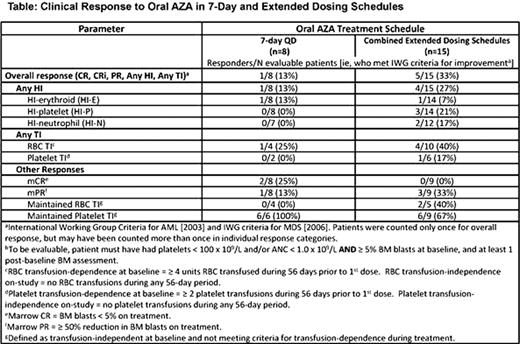Abstract
Abstract 1546
When administered subcutaneously (SC), the cytidine nucleoside analog azacitidine (AZA) has been shown to significantly improve overall survival in patients (pts) with low-blast count (20%–30%) AML compared with conventional care regimens (Fenaux, JCO, 2010). An oral AZA formulation would be more convenient for pts, increase access to treatment, allow extended dosing schedules, and may improve efficacy. An initial study of oral AZA administered once daily on a 7-day schedule demonstrated it to be bioavailable, safe, and clinically active in pts with myelodysplastic syndromes (MDS) or chronic myelomonocytic leukemia (CMML) (Garcia-Manero, JCO, 2011).
To present results of a multicenter phase I study of the safety, pharmacokinetic (PK) and pharmacodynamic (PD) profiles, and preliminary hematologic response rates in pts with AML receiving varying dose regimens of oral AZA.
Pts aged ≥ 18 years with AML who were not candidates for other therapies (but who may have failed prior treatment) were included. In Part 1, pts received an initial cycle of SC AZA 75 mg/m2 QD x 7 days of a 28-day cycle. Thereafter, oral AZA (120–600 mg QD) was given for 7 days of repeated 28-day cycles. In Part 2, pts received only oral AZA, in 1 of 4 extended dosing schedules: 300 mg QD or 200 mg BID, each for 14 or 21 days of 28-day cycles. Oral AZA was continued until disease progression or withdrawal for other reasons. PK was assessed during the first cycle of oral AZA treatment and DNA methylation was assessed during cycles 1 and 2 of oral AZA (Infinium Methylation27 BeadArray). Pts were monitored continuously for adverse events (AEs) and assessed for treatment response (Cheson, JCO, 2003; Cheson, JCO, 2006) at the end of every second cycle.
In all, 23 pts (median age 68 years [range 44–85], 13 male/10 female) with AML (13 de novo, 10 transformed from MDS) have received oral AZA on 7-day QD (n=8), 14-day QD (n=4), 21-day QD (n=4), 14-day BID (n=4), or 21-day BID (n=3) treatment schedules. At baseline, 14 (61%) and 8 (35%) pts were red blood cell (RBC) or platelet transfusion dependent, respectively; 13 pts (57%) had prior AML treatment, primarily intensive chemotherapy. Eight pts had unfavorable and 12 pts had intermediate cytogenetics (data not available, n=3). At baseline, median (range) hematologic measures were WBC = 1.5 K/μL (0.4 − 21.2), ANC = 0.2 K/μL (0 − 3.5), platelets = 34.0 K/μL (6.0 − 102), and % BM blasts = 28.0% (2.0 − 92.0). Median duration of oral AZA (any regimen) was 4 cycles (range 1–14). Seven pts (30%) received ≥ 6 cycles of oral AZA and 16 pts discontinued before completing 6 cycles (Figure). PK results were consistent with recently published data (Garcia-Manero, JCO, 2011). Following a single 300 mg dose (n=8), AUC0-∞ = 230 ± 210 ng*hr/mL, Cmax = 150 ± 114 ng/mL, t1/2 = 0.54 ± 0.21 hr, and median Tmax = 0.8 hr. There was no accumulation following multiple doses. Compared with extrapolated cumulative exposure of SC AZA administered for 7 days per the approved dosing regimen, extrapolated cumulative exposures of oral AZA with extended dosing schedules ranged from 55% for 300 mg QD × 14 days to 104% for 200 mg BID × 21 days. Overall, hematologic improvement (HI) was achieved by 5 pts (22%) (Table). One pt receiving 7-day QD oral AZA achieved a CRi. Responses were seen in 3/13 pts with de novo AML and 3/10 with secondary AML (Figure), and in 2/13 pts with prior AML treatment and 4/10 pts without prior treatment. DNA methylation levels in whole blood were reduced after oral AZA in 4/7 tested pts. The most common AEs (any severity) were gastrointestinal. Most common grade 3–4 AEs were febrile neutropenia (35%), pneumonia and syncope (17% each), nausea (13%), and thrombocytopenia, diarrhea, fatigue, dehydration, headache and mental status changes (9% each). Two pts died due to causes related to AML, and 2 pts discontinued (treatment failure, withdrew consent), within the first 60 days on-study.
Oral AZA treatment was well tolerated in this AML population of pts who were not candidates for other therapy. The oral formulation showed biological activity by reducing DNA methylation. Oral AZA also showed clinical activity in these AML pts, many of whom had complex cytogenetics and/or had failed prior therapy before study entry.
Gore:Celgene Corporation: Consultancy, Equity Ownership, Research Funding. Off Label Use: Oral formulation for Azacitidine in AML patients. Cogle:Celgene Corporation: Research Funding. Skikne:Celgene Corporation: Employment, Equity Ownership. Laille:Celgene Corporation: Employment, Equity Ownership. Shi:Celgene Corporation: Employment, Equity Ownership. MacBeth:Celgene Corporation: Employment, Equity Ownership. Giordano:Celgene Corporation: Employment, Equity Ownership.
Author notes
Asterisk with author names denotes non-ASH members.



This feature is available to Subscribers Only
Sign In or Create an Account Close Modal